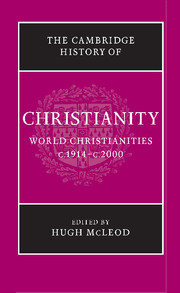Book contents
- Frontmatter
- 1 Introduction
- 2 Being a Christian in the early twentieth century
- PART I INSTITUTIONS AND MOVEMENTS
- PART II NARRATIVES OF CHANGE
- 8 The Great War
- 9 The Christian churches and politics in Europe, 1914–1939
- 10 Latin America, c.1914–c.1950
- 11 African Christianity: from the world wars to decolonisation
- 12 The African diaspora in the Caribbean and Europe from pre-emancipation to the present day
- 13 Christianity in the United States during the inter-war years
- 14 Christian churches in Australia, New Zealand and the Pacific, 1914–1970
- 15 Catholicism and Protestantism in the Second World War in Europe
- 16 The Cold War, the hegemony of the United States and the golden age of Christian democracy
- 17 The religious ferment of the sixties
- 18 The crisis of Christianity in the West: etering a post-Christian era?
- 19 The revolutions in eastern Europe and the beginnings of the post-communist era
- 20 The transformation of Latin American Christianity, c.1950–2000
- 21 Religion and racism: struggles around segregation, ‘Jim Crow’ and apartheid
- 22 Post-colonial Christianity in Africa
- 23 South Asia, 1911–2003
- 24 Christianity in South-East Asia, 1914–2000
- 25 East Asia
- PART III SOCIAL AND CULTURAL IMPACT
- Bibliography
- Index
- References
19 - The revolutions in eastern Europe and the beginnings of the post-communist era
from PART II - NARRATIVES OF CHANGE
Published online by Cambridge University Press: 28 March 2008
- Frontmatter
- 1 Introduction
- 2 Being a Christian in the early twentieth century
- PART I INSTITUTIONS AND MOVEMENTS
- PART II NARRATIVES OF CHANGE
- 8 The Great War
- 9 The Christian churches and politics in Europe, 1914–1939
- 10 Latin America, c.1914–c.1950
- 11 African Christianity: from the world wars to decolonisation
- 12 The African diaspora in the Caribbean and Europe from pre-emancipation to the present day
- 13 Christianity in the United States during the inter-war years
- 14 Christian churches in Australia, New Zealand and the Pacific, 1914–1970
- 15 Catholicism and Protestantism in the Second World War in Europe
- 16 The Cold War, the hegemony of the United States and the golden age of Christian democracy
- 17 The religious ferment of the sixties
- 18 The crisis of Christianity in the West: etering a post-Christian era?
- 19 The revolutions in eastern Europe and the beginnings of the post-communist era
- 20 The transformation of Latin American Christianity, c.1950–2000
- 21 Religion and racism: struggles around segregation, ‘Jim Crow’ and apartheid
- 22 Post-colonial Christianity in Africa
- 23 South Asia, 1911–2003
- 24 Christianity in South-East Asia, 1914–2000
- 25 East Asia
- PART III SOCIAL AND CULTURAL IMPACT
- Bibliography
- Index
- References
Summary
Catholic and Protestant churches under communism: communist policies and the response of the churches
Introduction
Communist rule was established in eastern Europe in the second half of the 1940s, and came to an end in 1989. Communist policy towards religion, and the response of the churches, varied widely in eastern Europe both geographically and over time.
One factor influencing the experience of Christians was their relative strength within the various countries. In some countries (Poland, Slovakia, Slovenia, Croatia, Lithuania) the historical close identification between the nation and the Catholic church continued. In East Germany, which lacked a distinctive national identity, the Protestant church was the predominant denomination. Other countries, particularly some of those straddling or bordering the ‘fault-line’ between Western and Eastern Christianity, remained religiously mixed. Hungary was Catholic, Reformed and Lutheran. In the Transylvanian part of Romania there was a large Reformed and Lutheran presence. Particularly strong in Transylvania, but also present elsewhere in the region, were Eastern-rite Catholics. Further south in the Balkans, the majority religion remained Orthodoxy, but in Albania Catholicism as well as Islam was important.
For political rather than purely ideological reasons the Eastern-rite Catholics were declared illegal throughout communist eastern Europe. (The largest Eastern-rite church to suffer this fate was the Ukrainian Catholic church in the Soviet Union, dissolved in 1946.) The only country, however, in which the theoretical communist ideological goal of the disappearance of all religion was said to have been achieved was Albania, where from 1967 it became illegal to manifest a religious faith in any way.
- Type
- Chapter
- Information
- The Cambridge History of Christianity , pp. 348 - 365Publisher: Cambridge University PressPrint publication year: 2006
References
- 1
- Cited by



